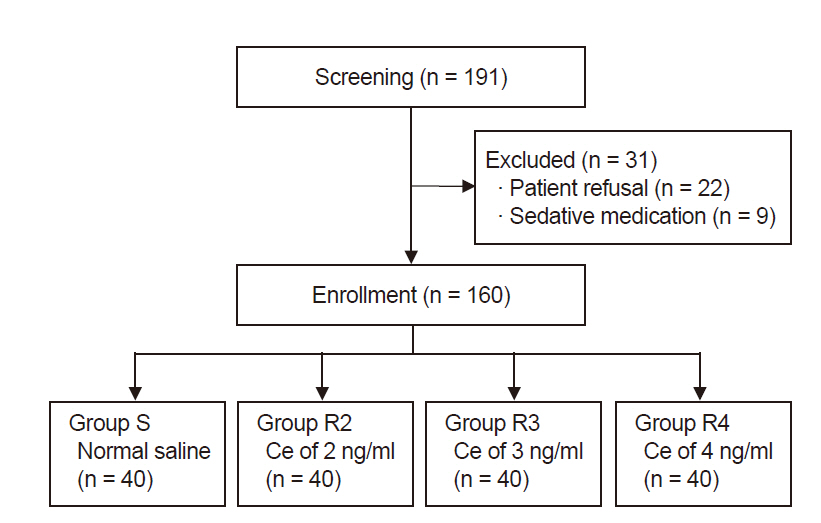Anesth Pain Med.
2020 Apr;15(2):152-156. 10.17085/apm.2020.15.2.152.
Effect-site concentration of remifentanil for preventing propofol injection pain during induction of balanced anesthesia
- Affiliations
-
- 1Department of Anesthesiology and Pain Medicine, Chonnam National University Medical School, Gwangju, Korea
- 2Department of Anesthesiology and Pain Medicine ,Chonnam National University Hospital, Gwangju, Korea
- KMID: 2500965
- DOI: http://doi.org/10.17085/apm.2020.15.2.152
Abstract
- Background
Despite various strategies designed for preventing pain from propofol injection, it is still common and distressing to the patients. The purpose of the present study was to investigate the adequate effect-site concentration (Ce) of remifentanil to prevent pain due to propofol injection.
Methods
A total of 160 adults scheduled for elective surgery were randomly assigned to one of four groups receiving normal saline (group S) or remifentanil at a Ce of 2 (group R2), 3 (group R3), or 4 (group R4), administered via target-controlled infusion, followed by the injection of 2 mg/kg of propofol (delivered with 1% lipid propofol). The severity and incidence of injection pain were assessed on a four-point scale.
Results
The incidence of propofol injection pain was significantly lower in group R2, R3, or R4 than in group S (30%, 5%, or 2.5% vs. 70%, respectively). Moreover, the intensity of the pain was lesser in group R2, R3, or R4 than in group S. However, the incidence or severity of injection was not different between groups R3 and R4.
Conclusions
During the induction of balanced anesthesia using propofol injection, pretreatment with remifentanil at a target Ce of 3 ng/ml effectively reduced propofol injection pain in adults.
Keyword
Figure
Reference
-
1. Marik PE. Propofol: therapeutic indications and side-effects. Curr Pharm Des. 2004; 10:3639–49.2. Angelini G, Ketzler JT, Coursin DB. Use of propofol and other nonbenzodiazepine sedatives in the intensive care unit. Crit Care Clin. 2001; 17:863–80.3. Külling D, Rothenbühler R, Inauen W. Safety of nonanesthetist sedation with propofol for outpatient colonoscopy and esophagogastroduodenoscopy. Endoscopy. 2003; 35:679–82.4. Picard P, Tramèr MR. Prevention of pain on injection with propofol: a quantitative systematic review. Anesth Analg. 2000; 90:963–9.5. Jalota L, Kalira V, George E, Shi YY, Hornuss C, Radke O, et al. Prevention of pain on injection of propofol: systematic review and meta-analysis. BMJ. 2011; 342:d1110.6. Iyilikci L, Balkan BK, Gökel E, Günerli A, Ellidokuz H. The effects of alfentanil or remifentanil pretreatment on propofol injection pain. J Clin Anesth. 2004; 16:499–502.7. Roehm KD, Piper SN, Maleck WH, Boldt J. Prevention of propofol-induced injection pain by remifentanil: a placebo-controlled comparison with lidocaine. Anaesthesia. 2003; 58:165–70.8. Basaranoglu G, Erden V, Delatioglu H, Saitoglu L. Reduction of pain on injection of propofol using meperidine and remifentanil. Eur J Anaesthesiol. 2005; 22:890–2.9. Egan TD, Kern SE, Muir KT, White J. Remifentanil by bolus injection: a safety, pharmacokinetic, pharmacodynamic, and age effect investigation in human volunteers. Br J Anaesth. 2004; 92:335–43.10. Lee JR, Jung CW, Lee YH. Reduction of pain during induction with target-controlled propofol and remifentanil. Br J Anaesth. 2007; 99:876–80.11. Minto CF, Schnider TW, Egan TD, Youngs E, Lemmens HJ, Gambus PL, et al. Influence of age and gender on the pharmacokinetics and pharmacodynamics of remifentanil. I. Model development. Anesthesiology. 1997; 86:10–23.12. King SY, Davis FM, Wells JE, Murchison DJ, Pryor PJ. Lidocaine for the prevention of pain due to injection of propofol. Anesth Analg. 1992; 74:246–9.13. Briggs LP, Clarke RS, Dundee JW, Moore J, Bahar M, Wright PJ. Use of di-isopropyl phenol as main agent for short procedures. Br J Anaesth. 1981; 53:1197–202.14. Scott RP, Saunders DA, Norman J. Propofol: clinical strategies for preventing the pain of injection. Anaesthesia. 1988; 43:492–4.15. Lee JY, Yang H, Choi SH, Shin DW, Hong SK, Chun DH. The optimal effect-site concentration of remifentanil to attenuate the pain caused by propofol. Korean J Anesthesiol. 2012; 63:108–12.16. Yon JH, Jo JK, Kwon YS, Park HG, Lee S. Effect-site concentration of remifentanil for blunting hemodynamic responses to tracheal intubation using light wand during target controlled infusion-total intravenous anesthesia. Korean J Anesthesiol. 2011; 60:398–402.
- Full Text Links
- Actions
-
Cited
- CITED
-
- Close
- Share
- Similar articles
-
- The optimal effect-site concentration of remifentanil to attenuate the pain caused by propofol
- Corrigendum: Effect-site concentration of remifentanil for preventing propofol injection pain during induction of balanced anesthesia
- Optimal effect-site concentration of remifentanil for preventing development of hypertension during tracheal intubation with inhaled desflurane induction
- The effect of gender on EC50 of remifentanil to prevent pain during injection of microemulsion propofol
- The effect of pretreatment with two different concentrations of remifentanil on propofol injection pain


